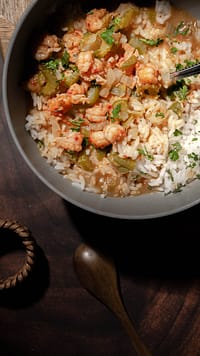Introduction
Crawfish Étouffée is a quintessential Cajun dish that embodies the rich, flavorful traditions of Louisiana cuisine. Originating in the bayous of Louisiana, this hearty stew-like dish has become a beloved staple in both Cajun and Creole cooking. The word “étouffée” (pronounced eh-too-fay) means “smothered” in French, aptly describing the cooking method where crawfish tails are smothered in a thick, spicy sauce.
Recipe Overview
At its heart Crawfish Étouffée is a harmonious blend of tender crawfish tails, aromatic vegetables, and a rich, flavorful sauce. The key ingredients include crawfish, the “holy trinity” of Cajun cooking (onions, celery, and bell peppers), garlic, and a roux-based sauce seasoned with Cajun spices. The dish is typically served over a bed of fluffy white rice, creating a comforting and satisfying meal.
Let’s break down this delicious dish into its main components and dive deep into each step of the cooking process.
The Roux: The Foundation of Flavor
Making the Perfect Roux
The roux is the backbone of many Cajun dishes, including Crawfish Étouffée. It’s a mixture of fat (in this case, butter) and flour, cooked together to create a thickening agent that also imparts a deep, nutty flavor to the dish.
Melt 6 tablespoons of unsalted butter in a heavy-bottomed pot over medium heat.
Add 1/2 cup of all-purpose flour and stir constantly.
Cook for 5-6 minutes until the roux reaches a light golden-brown color.
Tip: The key to a perfect roux is patience and constant stirring. Don’t rush this step, a good roux takes time and attention.
Variation: While butter is traditional, you can also use oil for a dairy-free version. Some cooks prefer a darker roux for a more intense flavor, but be careful not to burn it!
The Holy Trinity: Aromatics That Pack a Punch
Sautéing the Vegetables
The “holy trinity” in Cajun cooking consists of onions, celery, and bell peppers. This aromatic base forms the flavor foundation of many Cajun dishes.
Finely dice 1/2 cup onion, 2 tablespoons green bell pepper, and 2 tablespoons celery.
Mince 4 cloves of garlic.
Add these vegetables to the roux and cook for 6-8 minutes until softened.
Tip: Uniform, small dices ensure even cooking and help the vegetables meld into the sauce.
Variation: For a spicier version, you can add some diced jalapeños or substitute the green bell pepper with a hotter variety.
Building the Sauce: Where Magic Happens
Creating a Rich, Flavorful Base
This step is where we transform the roux and vegetables into a luscious sauce that will coat the crawfish.
Gradually add 4 cups of unsalted chicken or seafood broth, stirring constantly to prevent lumps.
Add 2 teaspoons Worcestershire sauce, 1 teaspoon hot sauce, 2 teaspoons Cajun seasoning, 1 teaspoon paprika, 1/2 teaspoon cayenne pepper, and 1 bay leaf.
Simmer for 8-10 minutes until slightly thickened.
Tip: Adding the broth gradually and stirring constantly is crucial to achieve a smooth sauce without lumps.
Variation: Adjust the spices to your taste. If you like it spicier, increase the cayenne pepper or hot sauce.
Adding the Star: Crawfish
Incorporating the Crawfish Tails
Now it’s time to add the star of the show – the crawfish tails.
Stir in 1 pound of peeled crawfish tails and 2 tablespoons of chopped green onions.
Simmer for 5-7 minutes, allowing the flavors to meld.
Tip: Be careful not to overcook the crawfish, as they can become tough. They’re ready when they’re heated through and have absorbed some of the sauce’s flavor.
Variation: If crawfish aren’t available, you can substitute shrimp for a different but equally delicious étouffée.
I remember the first time I made Crawfish Étouffée the aroma that filled my kitchen was intoxicating! It took me right back to my trip to New Orleans, where I first tasted this incredible dish in my grams kitchen. One mistake I made early on was rushing the roux, which resulted in a slightly burnt taste. I’ve learned that patience is key when it comes to Cajun cooking. Now, making étouffée has become a cherished tradition in my home, especially during crawfish season.

Crawfish Étouffée
Equipment
- Large heavy-bottomed pot or Dutch oven
- Sharp knife
- Measuring cups and spoons
- Wooden spoon or spatula
Ingredients
- 1 lb peeled crawfish tails
- 6 tablespoons unsalted butter
- 1/2 onion finely diced
- 1 green bell pepper seeded and finely diced
- 2 stalks celery finely diced
- 4 cloves garlic minced
- 1/2 cup all-purpose flour
- 4 cups unsalted chicken or seafood broth
- 2 green onions chopped
- 2 teaspoons Worcestershire sauce
- 1 teaspoon hot sauce adjust to taste
- 2 teaspoons Cajun or Creole seasoning
- 1 teaspoon paprika
- 1/2 teaspoon cayenne pepper adjust to taste
- 1 bay leaf
- Salt and black pepper to taste
- Fresh parsley chopped for garnish
- Cooked white rice for serving
Instructions
- Prepare the Vegetables: Finely dice the onion, green bell pepper, and celery. Mince the garlic.
- Make the Roux: In a large, heavy-bottomed pot or Dutch oven, melt the butter over medium heat. Add the flour and cook, stirring constantly, until the roux is a light golden-brown color, about 5-6 minutes.
- Sauté the Vegetables: Add the diced onion, bell pepper, celery, and minced garlic to the roux. Cook, stirring frequently, until the vegetables are softened, about 6-8 minutes.
- Build the Sauce: Gradually add the broth, stirring constantly to prevent lumps. Add the Worcestershire sauce, hot sauce, Cajun seasoning, paprika, cayenne pepper, and bay leaf. Bring the mixture to a simmer and cook for 8-10 minutes, until slightly thickened.
- Add the Crawfish: Stir in the crawfish tails and green onions. Simmer for an additional 5-7 minutes, allowing the flavors to meld together. Taste and adjust seasonings with salt and black pepper as needed.
- Serve: Remove the bay leaf. Serve the Crawfish Étouffée over a bed of fluffy white rice. Garnish with fresh chopped parsley.
Notes
- For the best flavor, use fresh crawfish tails when available.
- Adjust the heat level by modifying the amount of cayenne pepper and hot sauce.
- Don’t rush the roux – it’s the foundation of your étouffée and contributes significantly to the flavor.
- For a thicker consistency, simmer the sauce longer before adding the crawfish.
- If you prefer a lighter color, you can make a blonde roux instead of cooking it to a golden-brown color.
Nutrition
Common Questions and Answers
Q: Can I use frozen crawfish tails?
A: Yes, frozen crawfish tails work well. Just be sure to thaw them completely and drain any excess liquid before adding to the sauce.
Q: Is Crawfish Étouffée spicy?
A: It can be, but the spice level is customizable. Adjust the cayenne pepper and hot sauce to your preference.
Q: Can I make this dish ahead of time?
A: Absolutely! In fact, many people believe it tastes even better the next day as the flavors have more time to meld.
Special Equipment and Techniques
While no special equipment is required, a heavy-bottomed pot or Dutch oven is ideal for making the roux and the sauce. It helps distribute heat evenly and prevents burning.
The key technique to master is making the roux. It requires constant attention and stirring to achieve the right color without burning.
Serving and Storage
Serve Crawfish Étouffée over a bed of fluffy white rice. Garnish with chopped fresh parsley for a pop of color and freshness.
To store, let the étouffée cool completely, then refrigerate in an airtight container for up to 3 days. Reheat gently on the stovetop, adding a splash of broth if needed to loosen the sauce.
Conclusion
Crawfish Étouffée is more than just a meal – it’s a journey into the heart of Cajun cuisine. While it may seem intimidating at first, with a little patience and attention to detail, you can create a dish that rivals any Louisiana restaurant. The key to success lies in taking your time with the roux, balancing the spices to your taste, and not overcooking the crawfish. So grab your pot, gather your ingredients, and let the good times roll – or as they say in Louisiana, “Laissez les bon temps rouler!”








i love crawfish